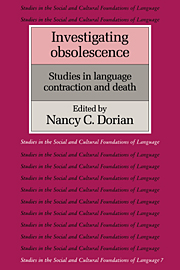Book contents
- Frontmatter
- Contents
- List of maps
- List of contributors
- Preface
- Map
- Dedication
- Introduction
- I Focus on context
- 1 On language death in eastern Africa
- 2 The disappearance of the Ugong in Thailand
- 3 Scottish and Irish Gaelic: The giant's bed-fellows
- 4 The rise and fall of an immigrant language: Norwegian in America
- 5 Breton vs. French: Language and the opposition of political, economic, social, and cultural values
- 6 “Persistence” or “tip” in Egyptian Nubian
- 7 Sociolinguistic creativity: Cape Breton Gaelic's linguistic “tip”
- 8 Skewed performance and full performance in language obsolescence: The case of an Albanian variety
- 9 On the social meaning of linguistic variability in language death situations: Variation in Newfoundland French
- 10 The social functions of relativization in obsolescent and non-obsolescent languages
- II Focus on structure
- III Invited commentaries
- Bibliography
- Index of languages
- General index
1 - On language death in eastern Africa
Published online by Cambridge University Press: 08 January 2010
- Frontmatter
- Contents
- List of maps
- List of contributors
- Preface
- Map
- Dedication
- Introduction
- I Focus on context
- 1 On language death in eastern Africa
- 2 The disappearance of the Ugong in Thailand
- 3 Scottish and Irish Gaelic: The giant's bed-fellows
- 4 The rise and fall of an immigrant language: Norwegian in America
- 5 Breton vs. French: Language and the opposition of political, economic, social, and cultural values
- 6 “Persistence” or “tip” in Egyptian Nubian
- 7 Sociolinguistic creativity: Cape Breton Gaelic's linguistic “tip”
- 8 Skewed performance and full performance in language obsolescence: The case of an Albanian variety
- 9 On the social meaning of linguistic variability in language death situations: Variation in Newfoundland French
- 10 The social functions of relativization in obsolescent and non-obsolescent languages
- II Focus on structure
- III Invited commentaries
- Bibliography
- Index of languages
- General index
Summary
Introduction
Eastern Africa does not constitute a unit linguistically or culturally. Instead, this area, roughly comprising the countries of Djibouti, Ethiopia, Kenya, Somalia, Sudan, Tanzania and Uganda, is characterized by a large variety of language families and groups on the one hand, and a considerable degree of cultural diversity on the other. In one sense the present geographical delimitation for the discussion of language obsolescence is therefore arbitrary. Such a regional approach, however, allows for a comparison of different circumstances relevant to the actuation problem of dying languages. One such variable concerns the social and economic structure of interacting groups, whilst a further variable relates to demographic factors.
The present contribution is directed towards disseminating general information on the causes and effects of language shift. It is not a survey of all known cases of language contraction and death in eastern Africa. Instances of partial and complete language shift are so numerous that it can be stated without exaggeration that most ethnic groups in this part of Africa, and probably elsewhere, are the result of an amalgamation of various groups which were distinct at an earlier stage. More specifically, this paper tries to provide answers, at least in part, to the following questions:
To what extent, and in what ways, do economic and social factors play a role as causal mechanisms in the gradual “default assignment” of certain languages?
How important is language as a potential symbol of ethnic identity relative to other symbols?
What kind of traces, linguistically or otherwise, does language shift leave behind, once the extinction of a particular language has become a fact?
- Type
- Chapter
- Information
- Investigating ObsolescenceStudies in Language Contraction and Death, pp. 13 - 32Publisher: Cambridge University PressPrint publication year: 1989
- 13
- Cited by



